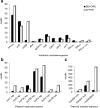Ecological effects of cefepime use during antibiotic cycling on the Gram-negative enteric flora of ICU patients
- PMID: 30054764
- PMCID: PMC6063807
- DOI: 10.1186/s40635-018-0185-2
Ecological effects of cefepime use during antibiotic cycling on the Gram-negative enteric flora of ICU patients
Abstract
This study examines the impact of cefepime and APP-β (antipseudomonal penicillin/ β-lactamase inhibitor combinations) on Gram-negative bacterial colonization and resistance in two Australian ICUs. While resistance did not cumulatively increase, cefepime (but not APP-β treatment) was associated with acquisition of antibiotic resistant Enterobacteriaceae, consistent with an ecological effect. Analysis of the resident gut E. coli population in a subset of patients showed an increase in markers of horizontal gene transfer after cefepime exposure that helps explain the increase in APP-β resistance and reminds us that unmeasured impacts on the microbiome are key outcome determinants that need to be fully explored.
Conflict of interest statement
Ethics approval and consent to participate
The previously published clinical component in the parent study (Ginn et al. 2012 [5]) was conducted under a waiver of consent, under the auspices of the relevant Human Research Ethics Committees of the Sydney West Area Health Service and the Royal Brisbane and Women’s Hospital
Consent for publication
Not applicable.
Competing interests
The authors declare that they have no competing interests.
Publisher’s Note
Springer Nature remains neutral with regard to jurisdictional claims in published maps and institutional affiliations.
Figures


Similar articles
-
Cefepime use in a pediatric intensive care unit reduces colonization with resistant bacilli.Pediatr Infect Dis J. 2003 Feb;22(2):109-14. doi: 10.1097/01.inf.0000050241.65703.2e. Pediatr Infect Dis J. 2003. PMID: 12586972
-
In Vitro Activity of Cefepime-Enmetazobactam against Gram-Negative Isolates Collected from U.S. and European Hospitals during 2014-2015.Antimicrob Agents Chemother. 2019 Jun 24;63(7):e00514-19. doi: 10.1128/AAC.00514-19. Print 2019 Jul. Antimicrob Agents Chemother. 2019. PMID: 30988152 Free PMC article.
-
WCK 5222 (cefepime/zidebactam) antimicrobial activity tested against Gram-negative organisms producing clinically relevant β-lactamases.J Antimicrob Chemother. 2017 Jun 1;72(6):1696-1703. doi: 10.1093/jac/dkx050. J Antimicrob Chemother. 2017. PMID: 28333332
-
Cefiderocol: A Siderophore Cephalosporin with Activity Against Carbapenem-Resistant and Multidrug-Resistant Gram-Negative Bacilli.Drugs. 2019 Feb;79(3):271-289. doi: 10.1007/s40265-019-1055-2. Drugs. 2019. PMID: 30712199 Review.
-
A resurgence of β-lactamase inhibitor combinations effective against multidrug-resistant Gram-negative pathogens.Int J Antimicrob Agents. 2015 Nov;46(5):483-93. doi: 10.1016/j.ijantimicag.2015.08.011. Epub 2015 Sep 25. Int J Antimicrob Agents. 2015. PMID: 26498989 Review.
Cited by
-
Effects of Antibiotic Treatment with Piperacillin/Tazobactam versus Ceftriaxone on the Composition of the Murine Gut Microbiota.Antimicrob Agents Chemother. 2021 Jan 20;65(2):e01504-20. doi: 10.1128/AAC.01504-20. Print 2021 Jan 20. Antimicrob Agents Chemother. 2021. PMID: 33168609 Free PMC article.
-
Third generation cephalosporins and piperacillin/tazobactam have distinct impacts on the microbiota of critically ill patients.Sci Rep. 2021 Mar 31;11(1):7252. doi: 10.1038/s41598-021-85946-4. Sci Rep. 2021. PMID: 33790304 Free PMC article.
References
-
- Lankelma JM, van Vught LA, Belzer C, Schultz MJ, van der Poll T, de Vos WM, Wiersinga WJ. Critically ill patients demonstrate large interpersonal variation in intestinal microbiota dysregulation: a pilot study. Intensive Care Med. 2016;43(1):59–68. doi: 10.1007/s00134-016-4613-z. - DOI - PMC - PubMed
-
- Ginn AN, Wiklendt AM, Gidding HF, George N, O’Driscoll JS, Partridge SR, O’Toole BI, Perri RA, Faoagali J, Gallagher JE, Lipman J, Iredell JR. The ecology of antibiotic use in the ICU: homogeneous prescribing of cefepime but not Tazocin selects for antibiotic resistant infection. PLoS One. 2012;7(6):e38719. doi: 10.1371/journal.pone.0038719. - DOI - PMC - PubMed
Publication types
Grants and funding
LinkOut - more resources
Full Text Sources
Other Literature Sources

